The (2+1)-Dimensional Chiral Nonlinear Schrödinger Equation: Extraction of Soliton Solutions and Sensitivity Analysis
Abstract
1. Introduction
2. Description of Proposed Model
3. Mathematical Formulation for the Generalized Arnous Method
Solution by Generalized Arnous Method
- Result 1:
- Result 2:
- Result 3:
4. Riccati Equation Method
Solution by the Reccati Equation Method
- Case 1: When , then we obtain following dark soliton solution (Figure 5)
- Case 2: When , then we derive the singular solution as (Figure 6)
- Case 3: When , then we obtain following periodic solution
- Case 4: When , then we derive following singular solutions (Figure 7)
- Case 5: When , then we obtain the following solution (Figure 8)
5. Sensitivity Analysis of Equation (1)
6. Conclusions
Author Contributions
Funding
Data Availability Statement
Acknowledgments
Conflicts of Interest
References
- Zhou, Q.; Zhu, Q.; Liu, Y.; Yu, H.; Yao, P.; Biswas, A. Thirring optical solitons in birefringent fibers with spatio-temporal dispersion and Kerr law nonlinearity. Laser Phys. 2014, 25, 015402. [Google Scholar] [CrossRef]
- Alquran, M. Physical properties for bidirectional wave solutions to a generalized fifth-order equation with third-order time-dispersion term. Results Phys. 2021, 28, 104577. [Google Scholar] [CrossRef]
- Cinar, M.; Secer, A.; Bayram, M. An application of Genocchi wavelets for solving the fractional Rosenau-Hyman equation. Alex. Eng. J. 2021, 60, 5331–5340. [Google Scholar] [CrossRef]
- Jaradat, I.; Alquran, M. A variety of physical structures to the generalized equal-width equation derived from Wazwaz-Benjamin-Bona-Mahony model. J. Ocean. Eng. Sci. 2022, 7, 244–247. [Google Scholar] [CrossRef]
- Iqbal, M.A.B.; Hussain, E.; Shah, S.A.A.; Li, Z.; Raza, M.Z.; Ragab, A.E.; Az-Zo’bi, E.A.; Ali, M.R. Theoretical examination and simulations of two nonlinear evolution equations along with stability analysis. Results Phys. 2024, 58, 107504. [Google Scholar] [CrossRef]
- Sadaf, M.; Arshed, S.; Akram, G.; Hussain, E. Dynamical behavior of nonlinear cubic-quartic Fokas-Lenells equation with third and fourth order dispersion in optical pulse propagation. Opt. Quantum Electron. 2023, 55, 1207. [Google Scholar] [CrossRef]
- Mahmood, I.; Hussain, E.; Mahmood, A.; Anjum, A.; Shah, S.A.A. Optical soliton propagation in the Benjamin–Bona–Mahoney–Peregrine equation using two analytical schemes. Optik 2023, 287, 171099. [Google Scholar] [CrossRef]
- Cinar, M.; Secer, A.; Ozisik, M.; Bayram, M. Derivation of optical solitons of dimensionless Fokas-Lenells equation with perturbation term using Sardar sub-equation method. Opt. Quantum Electron. 2022, 54, 402. [Google Scholar] [CrossRef]
- Matveev, V.B.; Salle, M.A. Darboux transformations and solitons. In Springer Series in Nonlinear Dynamics; Springer: Berlin/Heidelberg, Germany, 1991. [Google Scholar]
- Malik, S.; Kumar, S.; Biswas, A.; Yıldırım, Y.; Moraru, L.; Moldovanu, S.; Iticescu, C.; Alshehri, H.M. Cubic-quartic optical solitons in fiber bragg gratings with dispersive reflectivity having parabolic law of nonlinear refractive index by Lie symmetry. Symmetry 2022, 14, 2370. [Google Scholar] [CrossRef]
- Hirota, R. The Direct Method in Soliton Theory; Number 155; Cambridge University Press: Cambridge, UK, 2004. [Google Scholar]
- Liu, C.; Li, Z. The dynamical behavior analysis of the fractional perturbed Gerdjikov-Ivanov equation. Results Phys. 2024, 59, 107537. [Google Scholar] [CrossRef]
- Li, Z.; Liu, C. Chaotic pattern and traveling wave solution of the perturbed stochastic nonlinear Schrödinger equation with generalized anti-cubic law nonlinearity and spatio-temporal dispersion. Results Phys. 2024, 56, 107305. [Google Scholar] [CrossRef]
- Li, Z.; Hussain, E. Qualitative analysis and optical solitons for the (1+1)-dimensional Biswas-Milovic equation with parabolic law and nonlocal nonlinearity. Results Phys. 2024, 56, 107304. [Google Scholar] [CrossRef]
- Ablowitz, M.J.; Clarkson, P.A. Solitons, Nonlinear Evolution Equations and Inverse Scattering; Cambridge University Press: Cambridge, UK, 1991; Volume 149. [Google Scholar]
- Ma, W.; Strampp, W. An explicit symmetry constraint for the Lax pairs and the adjoint Lax pairs of AKNS systems. Phys. Lett. A 1994, 185, 277–286. [Google Scholar] [CrossRef]
- Weiss, J.; Tabor, M.; Carnevale, G. The Painlevé property for partial differential equations. J. Math. Phys. 1983, 24, 522–526. [Google Scholar] [CrossRef]
- Shabat, A.; Zakharov, V. Exact theory of two-dimensional self-focusing and one-dimensional self-modulation of waves in nonlinear media. Sov. Phys. JETP 1972, 34, 62. [Google Scholar]
- Zakharov, V.E.; Shabat, A.B. Interaction between solitons in a stable medium. Sov. Phys. JETP 1973, 37, 823–828. [Google Scholar]
- Gardner, C.S.; Greene, J.M.; Kruskal, M.D.; Miura, R.M. Method for solving the Korteweg-deVries equation. Phys. Rev. Lett. 1967, 19, 1095. [Google Scholar] [CrossRef]
- Lax, P.D. Integrals of nonlinear equations of evolution and solitary waves. In Selected Papers Volume I; Springer: Berlin/Heidelberg, Germany, 2005; pp. 366–389. [Google Scholar]
- Ablowitz, M.J.; Kaup, D.J.; Newell, A.C.; Segur, H. Nonlinear-evolution equations of physical significance. Phys. Rev. Lett. 1973, 31, 125. [Google Scholar] [CrossRef]
- Gel’fand, I.M.; Levitan, B.M. On the determination of a differential equation from its spectral function. Izv. Ross. Akad. Nauk. Seriya Mat. 1951, 15, 309–360. [Google Scholar]
- Marchenko, V. Concerning the theory of a differential operator of the second order. Doklady Akad. Nauk SSSR. (NS) 1950, 72, 457–460. [Google Scholar]
- Kay, I.; Moses, H. Reflectionless transmission through dielectrics and scattering potentials. J. Appl. Phys. 1956, 27, 1503–1508. [Google Scholar] [CrossRef]
- Agranovich, Z.; Marchenko, V. The Inverse Problem in the Quantum Theory of Scattering; Izd-vo Khar’kovskogo Universiteta: Kharkov, Ukraine, 1959. [Google Scholar]
- Faddeev, L.D. The inverse problem in the quantum theory of scattering. Uspekhi Mat. Nauk 1959, 14, 57–119. [Google Scholar]
- Hasegawa, A.; Tappert, F. Transmission of stationary nonlinear optical pulses in dispersive dielectric fibers. I. Anomalous dispersion. Appl. Phys. Lett. 1973, 23, 142–144. [Google Scholar] [CrossRef]
- Mollenauer, L.F.; Stolen, R.H.; Gordon, J.P. Experimental observation of picosecond pulse narrowing and solitons in optical fibers. Phys. Rev. Lett. 1980, 45, 1095. [Google Scholar] [CrossRef]
- Banerjee, P.P. Nonlinear Optics: Theory, Numerical Modeling, and Applications; CRC Press: Boca Raton, FL, USA, 2003. [Google Scholar]
- Agrawal, G.P. Nonlinear fiber optics. In Nonlinear Science at the Dawn of the 21st Century; Springer: Berlin/Heidelberg, Germany, 2000; pp. 195–211. [Google Scholar]
- Bulut, H.; Sulaiman, T.A.; Demirdag, B. Dynamics of soliton solutions in the chiral nonlinear Schrödinger equations. Nonlinear Dyn. 2018, 91, 1985–1991. [Google Scholar] [CrossRef]
- Alshahrani, B.; Yakout, H.; Khater, M.M.; Abdel-Aty, A.; Mahmoud, E.E.; Baleanu, D.; Eleuch, H. Accurate novel explicit complex wave solutions of the (2+ 1)-dimensional Chiral nonlinear Schrödinger equation. Results Phys. 2021, 23, 104019. [Google Scholar] [CrossRef]
- Hosseini, K.; Mirzazadeh, M. Soliton and other solutions to the (1+2)-dimensional chiral nonlinear Schrödinger equation. Commun. Theor. Phys. 2020, 72, 125008. [Google Scholar] [CrossRef]
- Eslami, M. Trial solution technique to chiral nonlinear Schrodinger’s equation in (1+2)-dimensions. Nonlinear Dyn. 2016, 85, 813–816. [Google Scholar] [CrossRef]
- Yıldırım, Y.; Biswas, A.; Ekici, M.; Triki, H.; Gonzalez, G.; Alzahrani, A.K.; Belic, M.R. Optical solitons in birefringent fibers for Radhakrishnan–Kundu–Lakshmanan equation with five prolific integration norms. Optik 2020, 208, 164550. [Google Scholar] [CrossRef]
- Bhan, C.; Karwasra, R.; Malik, S.; Kumar, S. Bifurcation, chaotic behavior and soliton solutions to the KP-BBM equation through new Kudryashov and generalized Arnous methods. AIMS Math. 2024, 9, 8749–8767. [Google Scholar] [CrossRef]
- Hussain, E.; Li, Z.; Shah, S.A.A.; Az-Zo’bi, E.A.; Hussien, M. Dynamics study of stability analysis, sensitivity insights and precise soliton solutions of the nonlinear (STO)-Burger equation. Opt. Quantum Electron. 2023, 55, 1274. [Google Scholar] [CrossRef]
- Hussain, E.; Mutlib, A.; Li, Z.; Adham, E.R.; Shah, S.A.A.; Az-Zo’bi, E.A.; Raees, N. Theoretical examination of solitary waves for Sharma–Tasso–Olver Burger equation by stability and sensitivity analysis. Z. Angew. Math. Phys. 2024, 75, 96. [Google Scholar] [CrossRef]

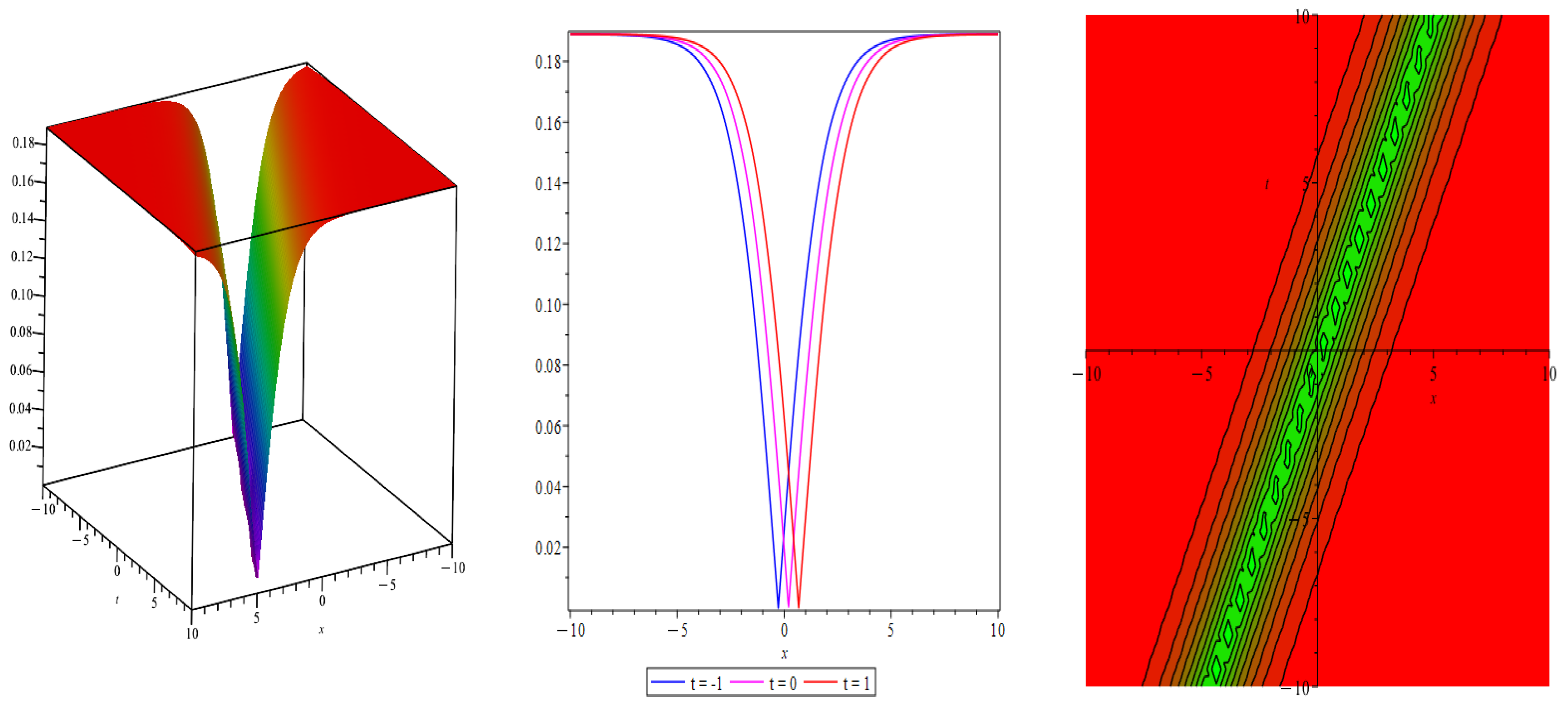
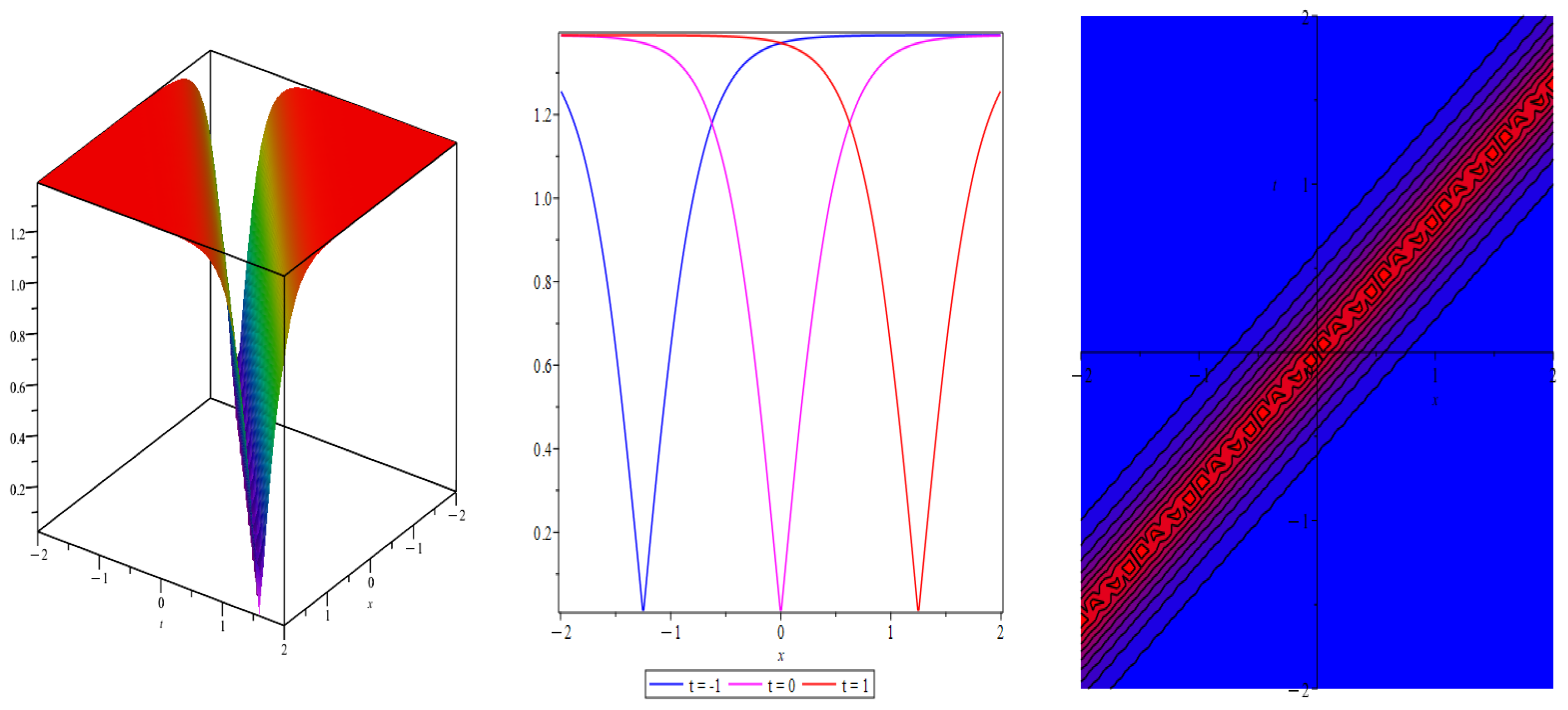

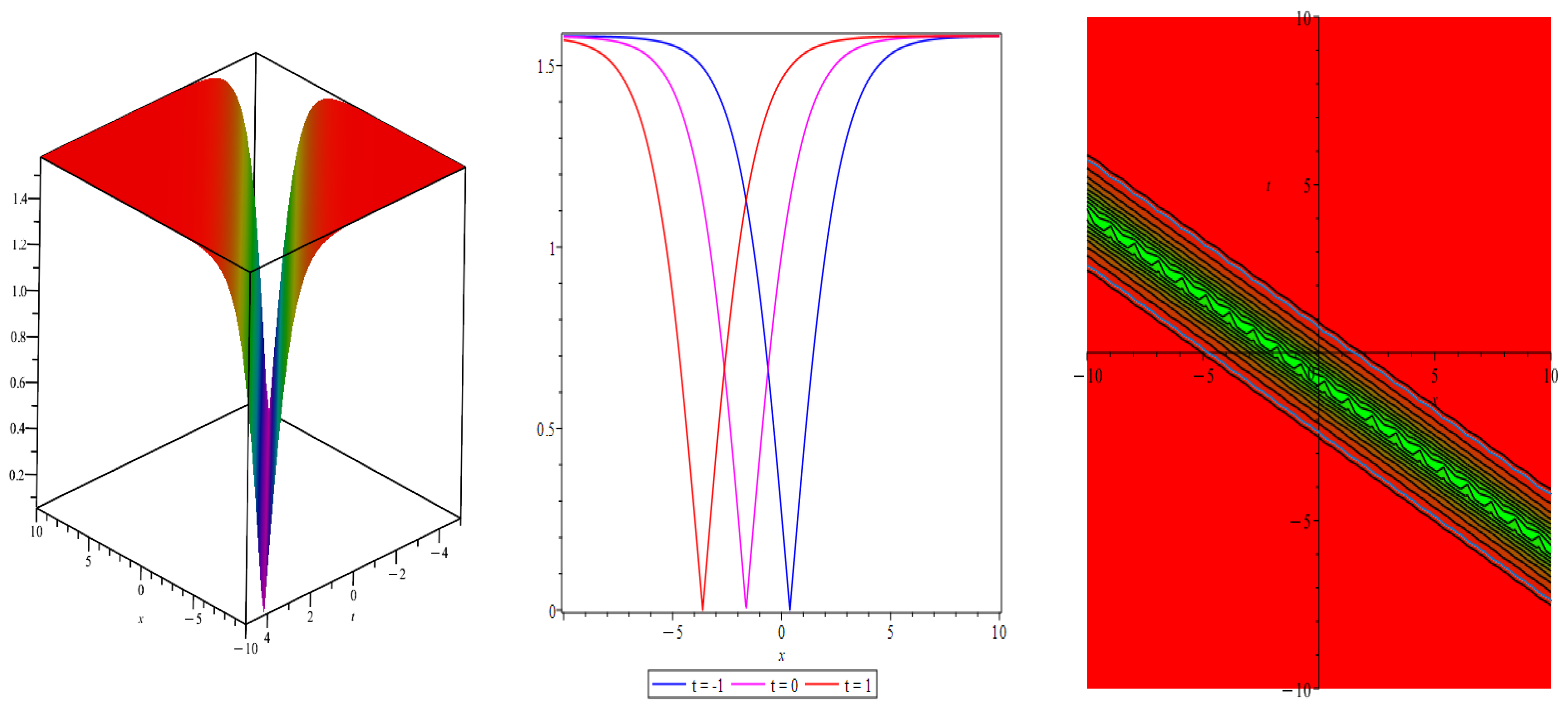
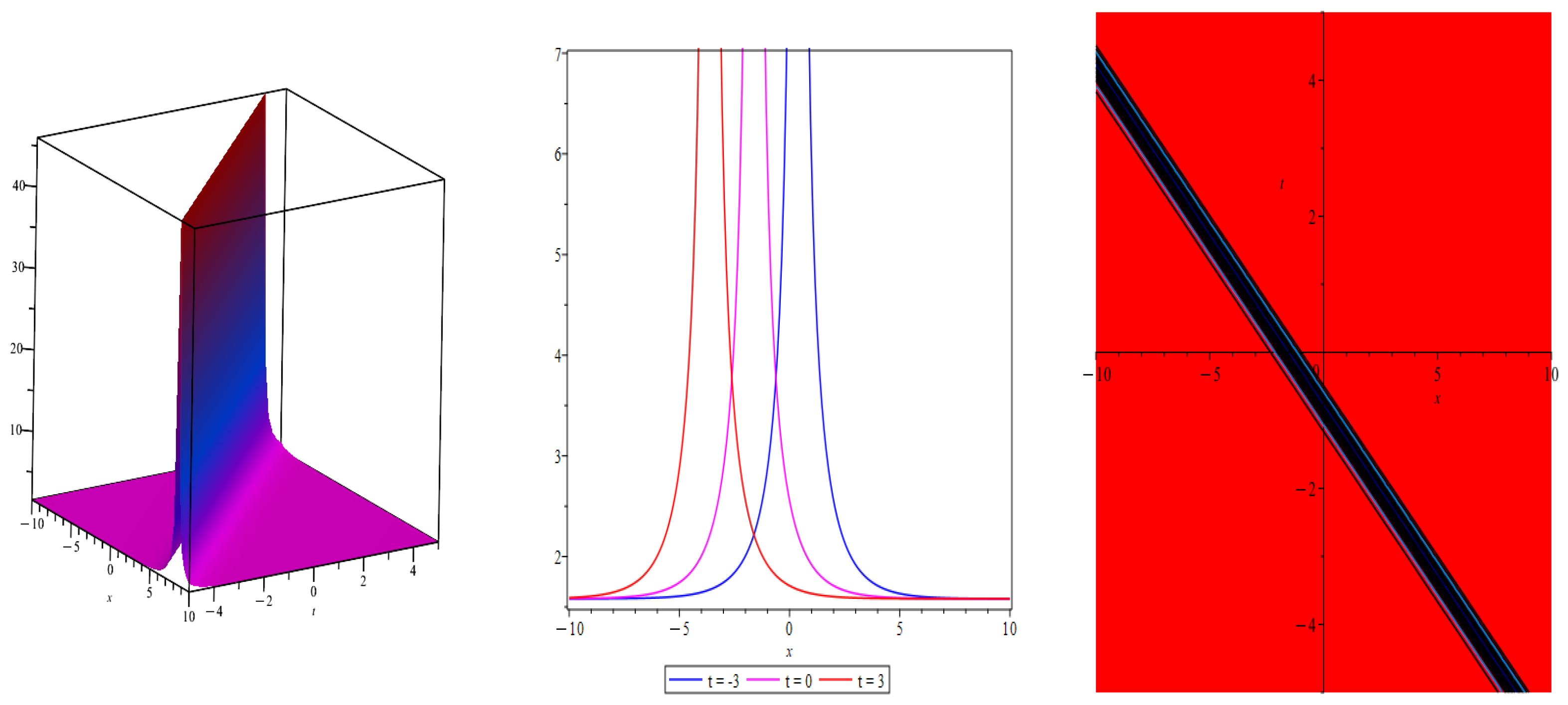
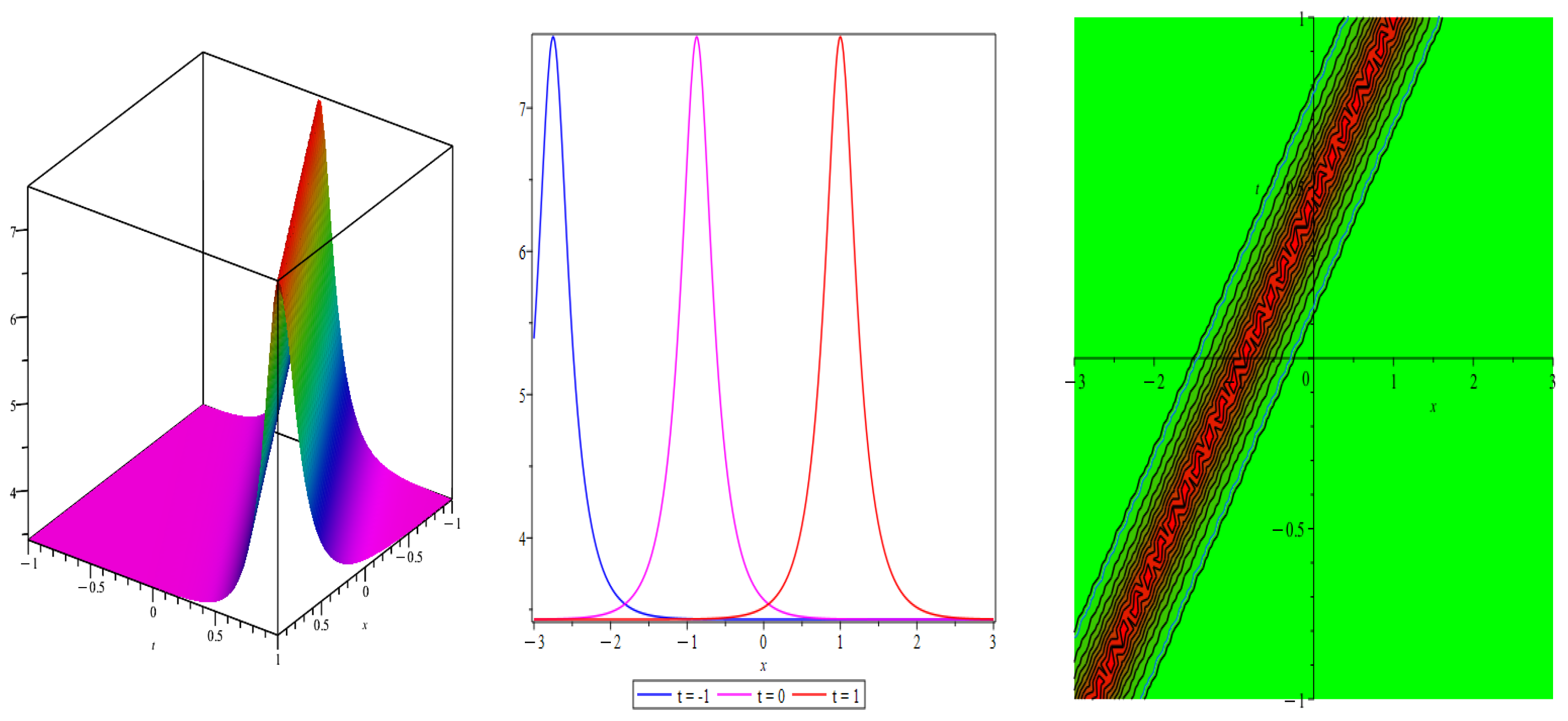
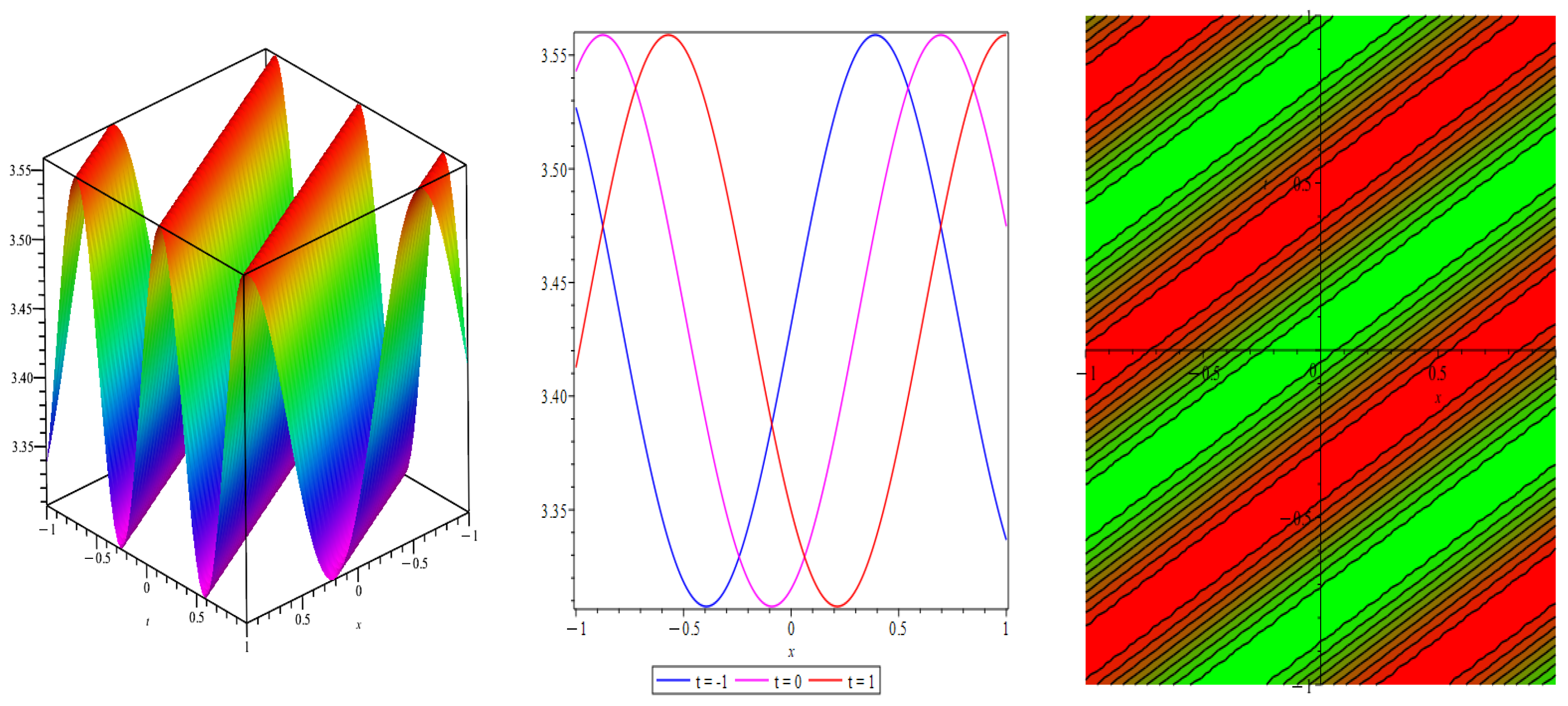
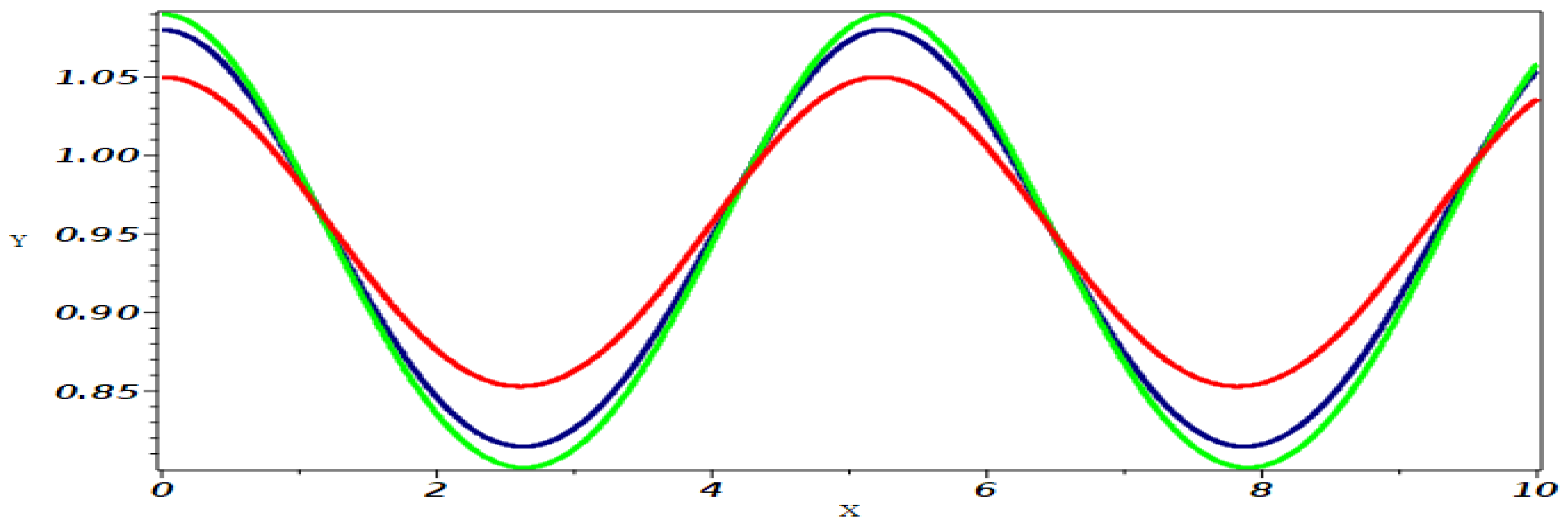
Disclaimer/Publisher’s Note: The statements, opinions and data contained in all publications are solely those of the individual author(s) and contributor(s) and not of MDPI and/or the editor(s). MDPI and/or the editor(s) disclaim responsibility for any injury to people or property resulting from any ideas, methods, instructions or products referred to in the content. |
© 2025 by the authors. Licensee MDPI, Basel, Switzerland. This article is an open access article distributed under the terms and conditions of the Creative Commons Attribution (CC BY) license (https://creativecommons.org/licenses/by/4.0/).
Share and Cite
Hussain, E.; Arafat, Y.; Malik, S.; Alshammari, F.S. The (2+1)-Dimensional Chiral Nonlinear Schrödinger Equation: Extraction of Soliton Solutions and Sensitivity Analysis. Axioms 2025, 14, 422. https://doi.org/10.3390/axioms14060422
Hussain E, Arafat Y, Malik S, Alshammari FS. The (2+1)-Dimensional Chiral Nonlinear Schrödinger Equation: Extraction of Soliton Solutions and Sensitivity Analysis. Axioms. 2025; 14(6):422. https://doi.org/10.3390/axioms14060422
Chicago/Turabian StyleHussain, Ejaz, Yasir Arafat, Sandeep Malik, and Fehaid Salem Alshammari. 2025. "The (2+1)-Dimensional Chiral Nonlinear Schrödinger Equation: Extraction of Soliton Solutions and Sensitivity Analysis" Axioms 14, no. 6: 422. https://doi.org/10.3390/axioms14060422
APA StyleHussain, E., Arafat, Y., Malik, S., & Alshammari, F. S. (2025). The (2+1)-Dimensional Chiral Nonlinear Schrödinger Equation: Extraction of Soliton Solutions and Sensitivity Analysis. Axioms, 14(6), 422. https://doi.org/10.3390/axioms14060422






